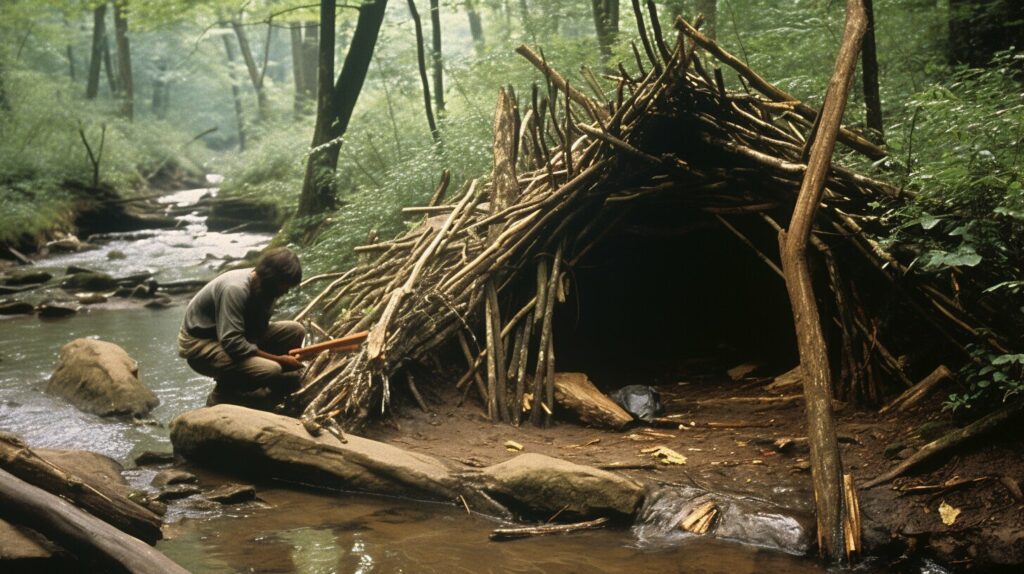
Building a bug out shelter is an essential aspect of emergency preparedness. Whether you’re a beginner or an expert prepper, this comprehensive guide will provide you with all the information you need to create a safe and comfortable shelter for survival. From choosing the right location to selecting the necessary supplies, this guide covers everything you’ll need to know.
Key Takeaways:
- A bug out shelter is crucial for ensuring your safety during disastrous events.
- Consider factors like accessibility, security, and resource availability when selecting the location for your bug out shelter.
- Gather essential supplies like water filtration systems, food rations, and communication devices to equip your shelter adequately.
- Prioritize safety and security when constructing your bug out shelter.
- Maintain and sustain your shelter through regular inspections and practice essential survival skills.
Why You Need a Bug Out Shelter
When it comes to emergency preparedness, having a bug out shelter is crucial. It provides you with a safe haven in the event of a disastrous event, ensuring your survival and the well-being of your loved ones. Natural disasters such as earthquakes, tornados, and chemical spills can quickly make your home unsafe, while unpredictable events like terrorist attacks can pose a serious threat to your security. Bugging out to a dedicated bug out shelter should be a last-resort solution when it is no longer safe to stay at home.
Having a bug out shelter allows you to escape the danger zone and find refuge in a location that is prepared to withstand various threats. It provides you with a sense of security and peace of mind, knowing that you have a designated place to go when disaster strikes. Your bug out shelter should be equipped with all the necessary supplies, including food, water, medical kits, and self-defense tools, to ensure your survival during the critical initial period after a disaster.
Additionally, a bug out shelter offers you the opportunity to create a self-sufficient and sustainable living environment. By choosing an off-grid or underground shelter, you can reduce your reliance on public utilities and ensure a continuous supply of basic necessities. This level of independence allows you to weather long-term disruptions to infrastructure and services, giving you a higher chance of survival in extended emergency situations.

Why You Need a Bug Out Shelter:
- To ensure your safety in the event of a disastrous event
- To find a safe haven away from harm
- To have a designated place with necessary supplies
- To create a self-sufficient and sustainable living environment
In conclusion, a bug out shelter is a critical component of emergency preparedness. It provides you with a safe and secure refuge when your home is no longer a viable option. By having a bug out shelter, you increase your chances of survival and ensure the well-being of your family during times of crisis. Remember, being prepared is key, so start planning and building your bug out shelter today.
How to Choose the Right Location
When it comes to building a bug out shelter, selecting the right location is crucial for your safety and survival. Consider the following factors to ensure you make an informed decision:
Accessibility
The location of your bug out shelter should be easily accessible in case of an emergency. Choose a spot that is within a reasonable distance from your home or workplace, allowing you to reach it quickly and efficiently. Accessibility also includes ease of navigation to and from the shelter, especially if you need to evacuate in a hurry.
Security
Security is of utmost importance when choosing a bug out shelter location. Look for a place that offers natural barriers or protection from potential threats. This can include selecting a site in a secluded area or one that is naturally hidden from view. Additionally, consider the overall safety of the region, including crime rates and potential hazards.
Availability of Resources
Depending on the type of bug out shelter you are planning to build, the availability of resources is essential. If you are opting for an off-grid shelter, ensure there are ample natural resources nearby, such as water sources and renewable energy options. If you plan to rely on the wilderness for survival, choose a location with abundant wildlife and edible plants.
By carefully considering these factors, you can select a bug out shelter location that meets your specific needs and maximizes your chances of survival in an emergency situation.

Table: Factors to Consider in Choosing a Bug Out Shelter Location
| Factor | Description |
|---|---|
| Accessibility | Choose a location that is easily accessible and allows for quick evacuation. |
| Security | Consider natural barriers and overall safety of the region to ensure security. |
| Availability of Resources | Assess nearby resources like water sources and renewable energy options for sustainability. |
Essential Supplies for Your Bug Out Shelter
When it comes to building a bug out shelter, having the right supplies is crucial for your survival. Whether you’re preparing for a natural disaster or an unforeseen event, being well-equipped with essential items can make all the difference. Here is a comprehensive list of supplies you should consider including in your bug out shelter:
Water Filtration Systems
Access to clean drinking water is essential for your survival. Invest in a reliable water filtration system that can remove contaminants and provide you with safe drinking water. Look for portable options that are easy to use and can purify water from various sources.
READ: Best Emergency Water Filter for Survival
Food Rations
Pack an ample supply of non-perishable food items in your bug out shelter. Choose items that are lightweight, have a long shelf life, and provide sufficient nutrition. Canned goods, protein bars, and dried fruits are excellent options to consider.
First Aid Kits
Accidents and injuries can happen in any emergency situation. Make sure you have a well-stocked first aid kit in your bug out shelter. Include items such as bandages, antiseptic ointments, pain relievers, and any necessary prescription medications.
Fire-Making and Shelter Construction Tools
Being able to start a fire and construct a shelter are vital skills for survival. Pack fire-starting tools such as waterproof matches, lighters, and fire starters. Additionally, include tools such as a folding saw, multi-tool, and paracord for shelter construction.
Communication Devices
In an emergency situation, communication is key. Have a reliable communication device in your bug out shelter, such as a two-way radio or a satellite phone. These devices can help you stay connected with loved ones or emergency services if necessary.
READ: Best GMRS Radio: Top Pick for Clear Communication
Building a Safe and Secure Shelter
When it comes to constructing a bug out shelter, safety and security should be your top priorities. You want a shelter that can withstand natural disasters and protect you from external threats. By choosing sturdy materials and reinforcing the structure, you can ensure durability and resilience.
One important aspect of building a safe and secure shelter is selecting the right materials. Look for materials that are strong and can withstand harsh weather conditions. Metal or concrete can provide excellent durability and protection. Consider reinforcing the walls and roof to make them more resistant to impact and collapse.
Security features are also essential for a bug out shelter. Reinforce your doors with heavy-duty locks and bolts to prevent unauthorized access. Consider installing a security system that includes cameras and motion sensors for added protection. Remember to keep a low profile and avoid drawing attention to your shelter, as secrecy is crucial for your safety.“By choosing sturdy materials and reinforcing the structure, you can ensure durability and resilience.”
Comparison of Shelter Security Features
| Shelter Type | Security Features |
|---|---|
| Survival Shelter | Reinforced walls and roof, heavy-duty locks |
| Doomsday Shelter | Underground location, reinforced blast doors, advanced security systems |
By incorporating these safety and security measures into your bug out shelter, you can create a haven that will protect you during times of crisis. Prioritize durability, reinforce the structure, and implement effective security features to ensure your safety and peace of mind.

Shelter Maintenance and Sustainability
Maintaining your bug out shelter is crucial for long-term sustainability and preparedness. Regular inspections and proper upkeep ensure that your shelter is always ready for use and can withstand any challenges that may arise. Additionally, implementing sustainable practices can help you reduce your environmental impact and increase self-sufficiency.
When it comes to shelter maintenance, start by conducting regular inspections to identify any damages or weaknesses. Check for leaks, cracks, or structural issues that need immediate attention. Repair any damages promptly to ensure the integrity of your shelter. It is also essential to keep your shelter well-stocked with supplies. Regularly rotate perishable items such as food and medications to maintain freshness and ensure availability.
If your bug out shelter is an off-grid or underground shelter, you’ll need to pay extra attention to the maintenance of your power and water systems. Regularly inspect and maintain your solar panels, batteries, and other power sources to ensure they are operating efficiently. Similarly, check your water filtration and storage systems to ensure clean and accessible water. Consider implementing sustainable practices such as rainwater harvesting and utilizing renewable energy sources to reduce your reliance on external resources.

By maintaining your bug out shelter and implementing sustainable practices, you can ensure that your shelter remains a reliable and self-sufficient haven in times of emergency. Regular inspections, proper upkeep, and the use of renewable resources will help you stay prepared for any situation that may arise.
READ: Best Hiking Solar Chargers for Off-Grid
Remember, practice these skills regularly to maintain proficiency. Each skill is essential for surviving and thriving in a bug out shelter, so invest time and effort in honing your abilities. Keep in mind that these skills are just a few examples, and there are many other valuable skills that can enhance your chances of survival in the wilderness.

Expert Tip:
Always check your bug out bag regularly and update the supplies as needed. Rotate food rations and check expiration dates on medications to ensure everything remains fresh and effective.

Bug Out Bag Essentials
| Item | Description |
|---|---|
| Food Rations | Pack non-perishable food items that provide energy and sustenance. |
| Water Purification Tablets | Ensure access to clean drinking water by using purification tablets. |
| A First Aid Kit | Include medical supplies and necessary medications for emergencies. |
| Fire-making and Shelter Construction Tools | Pack lightweight tools to create fire and build temporary shelter. |
| Necessary Personal Documents | Carry copies of identification, insurance papers, and other important documents. |
Conclusion and Final Thoughts
Building a bug out shelter is an essential part of being prepared for emergencies. It provides a safe and secure haven during times of crisis, ensuring your survival and that of your loved ones. By following the comprehensive guide provided in this article and considering your specific needs and circumstances, you can create a bug out shelter that meets all your requirements.
Remember, regular maintenance is key to keeping your shelter in top condition. Conduct inspections regularly to identify any damages or weaknesses and make the necessary repairs. Additionally, acquiring essential survival skills such as fire-making, water purification, and foraging for food will greatly enhance your chances of survival.
Don’t forget to prepare a well-equipped bug out bag for quick evacuation from your shelter if needed. This bag should contain essential items such as food rations, water purification tablets, a first aid kit, and necessary personal documents. Pack lightweight and portable items to ensure ease of carrying.
By taking these steps and being proactive in your emergency preparedness, you can face any disaster with confidence. Stay safe, be prepared, and remember that your bug out shelter is your lifeline during times of crisis.
